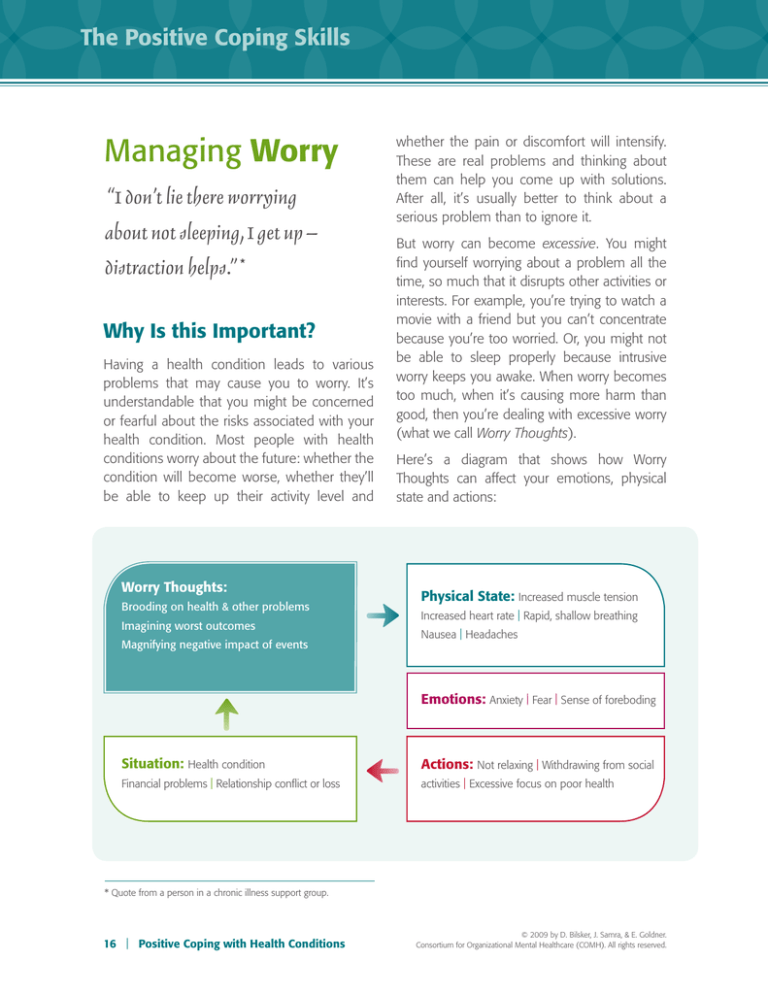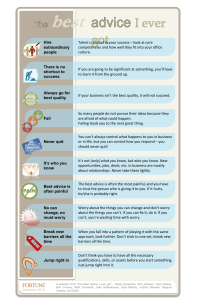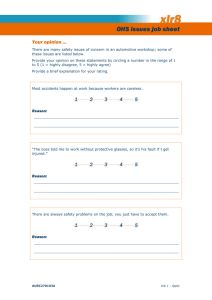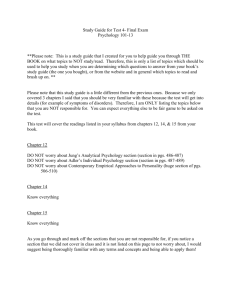
The Positive Coping Skills
Managing Worry
“I don’t lie there worrying
about not sleeping, I get up –
distraction helps.” *
Why Is this Important?
Having a health condition leads to various
problems that may cause you to worry. It’s
understandable that you might be concerned
or fearful about the risks associated with your
health condition. Most people with health
conditions worry about the future: whether the
condition will become worse, whether they’ll
be able to keep up their activity level and
Worry Thoughts:
Brooding on health & other problems
Imagining worst outcomes
Magnifying negative impact of events
whether the pain or discomfort will intensify.
These are real problems and thinking about
them can help you come up with solutions.
After all, it’s usually better to think about a
serious problem than to ignore it.
But worry can become excessive. You might
find yourself worrying about a problem all the
time, so much that it disrupts other activities or
interests. For example, you’re trying to watch a
movie with a friend but you can’t concentrate
because you’re too worried. Or, you might not
be able to sleep properly because intrusive
worry keeps you awake. When worry becomes
too much, when it’s causing more harm than
good, then you’re dealing with excessive worry
(what we call Worry Thoughts).
Here’s a diagram that shows how Worry
Thoughts can affect your emotions, physical
state and actions:
Physical State: Increased muscle tension
Increased heart rate | Rapid, shallow breathing
Nausea | Headaches
Emotions: Anxiety | Fear | Sense of foreboding
Situation: Health condition
Actions: Not relaxing | Withdrawing from social
Financial problems | Relationship conflict or loss
activities | Excessive focus on poor health
* Quote from a person in a chronic illness support group.
16 | Positive Coping with Health Conditions
© 2009 by D. Bilsker, J. Samra, & E. Goldner.
Consortium for Organizational Mental Healthcare (COMH). All rights reserved.
Managing Worry
How Can I Reduce
My Worrying?
We’re going to show you how to reduce
excessive worrying and how to worry
more effectively.
The steps toward Managing
Worry are:
1. Identify Worry Thoughts
2. Challenge Worry Thoughts
3. Practice calming and
realistic thinking
4. Schedule Worry Time
5. Use these methods to
protect your sleep
1
Identify Worry
Thoughts
• You experience a high level of anxiety along
with the worrying thoughts, whether the
anxiety is felt physically (tense muscles,
increased heart rate, rapid breathing,
headache, stomach problems, etc.) or
emotionally (fearfulness, apprehension,
sense of impending doom).
• You have difficulty falling asleep or wake
frequently during the night because of
your worry.
• You rarely come up with a better understanding
of the problem or new solutions – usually,
your worrying just goes in circles, around and
around the same kinds of problems without
leading to any useful action.
• You find yourself trying to suppress the
Worry Thought, to “stop thinking it.” Although
it’s understandable that you would want this
worrying to stop, just ordering yourself to stop
thinking it usually doesn’t work. Sometimes,
the harder you try to stop a Worry Thought,
the more frequently it returns!
Worry Thoughts can be recognized by at least
one of these features:
• You think too much about a problem, to the
point that it interferes with other activities.
Thinking so much about the problem makes
it difficult to be with family or friends, enjoy
entertainment or concentrate on work.
• You imagine the worst possible outcome of
the problem, mentally magnifying the negative possibilities and ignoring any possible
positive outcomes. This kind of thinking is
known as “catastrophizing.”
© 2009 by D. Bilsker, J. Samra, & E. Goldner.
Consortium for Organizational Mental Healthcare (COMH). All rights reserved.
Positive Coping with Health Conditions | 17
The Positive Coping Skills
When you worry excessively, it usually feels like
you are problem solving, but it doesn’t take you
any closer to finding real solutions. Here are
two common types of Worry Thoughts:
to ask yourself, “How often has this happened
before?” and “What is the realistic likelihood
that this will actually happen?” You can get this
information from your healthcare provider.
Overestimating the Likelihood that Bad
Things Will Happen
Catastrophizing
You tell yourself that a very bad outcome
will certainly happen, even when you’ve
been reliably told that a very bad outcome
is unlikely. For example, you tell yourself that
you will become physically helpless and
totally dependent on other people, even after
you’ve been told by your physician that only a
tiny proportion of people with your condition
become extremely impaired. It can be helpful
You magnify how bad the situation is or how
bad a future situation will be – you see the
situation as more dangerous or unbearable
than the facts justify. For example, if you have
a heart condition, you tell yourself that any
physical exertion will trigger a heart attack or
injure your heart muscles, even though your
physician told you that mild physical exertion
is good for you and very unlikely to cause a
problem with your heart.
Write down some Worry Thoughts that have been bothering you lately:
18 | Positive Coping with Health Conditions
© 2009 by D. Bilsker, J. Samra, & E. Goldner.
Consortium for Organizational Mental Healthcare (COMH). All rights reserved.
Managing Worry
2
Challenge
Worry Thoughts
(and replace them with realistic ones)
Coping with Worry Thoughts involves
deliberately rethinking situations that cause
you anxiety. You can use a strategy called
Challenging Worry Thoughts.
Think of a situation about which you’ve been
worrying. First, make a brief note about the
situation. Second, write down the Worry
Thoughts that were making you anxious. Third,
think about the situation and try to come up
with more calming and realistic thoughts, using
the Reality Questions below.
Would most people agree with this
thought? If not, what would most
people think?
Just by imagining how most people would react
to a Worry Thought, you might be able to come
up with a more fair and realistic way of thinking.
When you step outside yourself and examine
your thinking from another perspective, it’s easier
to see how your thoughts might be distorted.
What would I say to a friend, if my
friend were in a similar situation?
If a friend of yours were worrying too much,
what would you say to her? It’s likely that you
would be able to help her think about the
situation more fairly, looking at it in a more
balanced way. You might remind your friend of
tough situations she handled in the past. You
might find it easier to think in a realistic way for
a friend than for yourself.
What will happen if I continue to think
this way?
? Reality Questions
Can I get more evidence, maybe by
asking someone about the situation?
It’s often helpful to get another person’s opinion
about the situation. For example: you’ve been
worrying constantly that your health will keep
getting worse – so you speak to the clinic nurse,
who informs you that most people with your health
condition are able to stabilize their symptoms.
© 2009 by D. Bilsker, J. Samra, & E. Goldner.
Consortium for Organizational Mental Healthcare (COMH). All rights reserved.
It’s important to understand what results are likely
if you continue to worry excessively. Consider
the effect of worry on your enjoyment of time
with other people, willingness to try activities,
ability to get restful sleep, physical symptoms,
etc. What might be the results for you and
others if you continue to worry excessively?
What is a more encouraging or useful
way of thinking?
Can you come up with another thought that
would have better results? Is there a way of
thinking that would be more encouraging and
helpful in improving the situation?
Positive Coping with Health Conditions | 19
The Positive Coping Skills
Example:
This is how Alice, a young woman dealing with
chronic pain, answered these questions:
Worry Thought:
What if the pain just gets worse and
worse, until I can’t work anymore?
Can I get more evidence, maybe by asking someone about the situation?
I asked my family physician – she told me
that my pain has likely stabilized and that
I can probably make some improvements by
participating in my pain management group.
The group leader thinks I will be able to improve
my activity level and my pain management.
Would most people agree with this
thought? If not, what would most
people think?
My friends think I’m being too pessimistic – but
I’m not sure they really understand what this
kind of pain is like.
What would I say to a friend, if my friend
were in a similar situation?
I would never say that kind of thing to a
friend, especially when it’s far from certain. It’s
too discouraging.
What will happen if I continue to think
this way?
I’ve been so worried that I’ve been having
problems concentrating at work. Also, I’m
sleeping badly, partly because of worry,
and that will become a big problem if it
doesn’t improve.
20 | Positive Coping with Health Conditions
What is a more encouraging or useful
way of thinking?
I need to keep reminding myself that my pain is
most likely to stay the same or even get better
– especially if I practice the pain management
methods I’m learning in the pain group.
To the right is a worksheet you can use to come up
with more calming and realistic thoughts. Make
extra copies if you need to. Do this worksheet
for at least one of your Worry Thoughts.
3
Practice Calming and
Realistic Thinking
It’s not enough to come up with a calming
and realistic thought just once. Worry Thoughts
can repeat over and over, until they become
automatic. More balanced thinking will help you
feel better, but it won’t be automatic – at least
not for a while. The good news is that reducing
worry doesn’t take years. In fact, people who
have been worrying excessively often begin to
notice a difference after only a few weeks of
practicing the Managing Worry skill.
Stressful situations can trigger worry. Examples
of stressful situations are:
• An increase in physical symptoms or pain
• Forgetting to take your medication
• Visiting a new specialist
In order to get the greatest benefit from this
skill, you must pay attention to your thinking in
situations that are likely to trigger worry.
© 2009 by D. Bilsker, J. Samra, & E. Goldner.
Consortium for Organizational Mental Healthcare (COMH). All rights reserved.
Managing Worry
Worry Thought:
Can I get more evidence, maybe by asking someone about the situation?
Would most people agree with this thought? If not, what would most people think?
What would I say to a friend, if my friend were in a similar situation?
What will happen if I continue to think this way?
What is a more encouraging or useful way of thinking?
© 2009 by D. Bilsker, J. Samra, & E. Goldner.
Consortium for Organizational Mental Healthcare (COMH). All rights reserved.
Positive Coping with Health Conditions | 21
The Positive Coping Skills
Write down a few situations where you often have Worry Thoughts:
When you find yourself in stressful situations,
deliberately practice calming thinking. Don’t
assume that it will happen on its own. You have
to tell yourself how to look at the situation, just
as you might give advice to a friend. Talk back to
the worry thinking. Don’t allow excessive worry
to occur without replying to it. Every time you
talk back, you make the worry thinking weaker
and the realistic thinking stronger. Eventually,
realistic thoughts will have more influence over
you than Worry Thoughts.
22 | Positive Coping with Health Conditions
© 2009 by D. Bilsker, J. Samra, & E. Goldner.
Consortium for Organizational Mental Healthcare (COMH). All rights reserved.
Managing Worry
In the beginning, realistic thinking can seem
false. If your thinking has been distorted for
some time, it can be difficult to see the truth.
Imagine that you’ve been asking yourself
repeatedly, “What if I keep getting worse?
What if my illness is more serious than my
doctors realize? What if I’m the rare case?”
Having these thoughts regularly will cause you
to feel anxious. Let’s say you recognize this as
unrealistic thinking and instead come up with
a realistic thought: “There’s a high probability
that I won’t get worse, in fact that I will get
better, so why waste my time thinking about
very unlikely outcomes?” At first, this realistic
thought will seem false, as though you’re just
fooling yourself. Only with time and repetition
will realistic thinking – the truth – begin to feel
true. Eventually you’ll come to accept realistic
thoughts more naturally.
4
Schedule
Worry Time
A big problem with excessive worry is that it
interferes while you’re trying to do something
else – watch a movie, talk with a friend, or
concentrate on a book, for example. This leads
to negative results: first, it’s harder to enjoy these
activities or do them properly; and second, you
don’t get to focus properly on the problems
you’re worrying about because you’re distracted
by the other activity! You can’t watch a movie
and think about an important problem at the
same time. Both activities will suffer.
© 2009 by D. Bilsker, J. Samra, & E. Goldner.
Consortium for Organizational Mental Healthcare (COMH). All rights reserved.
As we explained above, trying to force yourself
to “stop thinking it” doesn’t usually work. But
what you can do instead is schedule a particular
time during the week when you will concentrate
on worrying about your problems. During this
Worry Time, you’re not allowed to do anything
that would distract you from worrying. Schedule
a particular time when you can set aside an
hour just for worrying, making sure that you
won’t be interrupted during this important task.
Make sure to write this Worry Time into your
schedule and do it at the time you’ve set, and
only at that time.
The aim of this scheduled Worry Time is to
allow you to worry towards solution instead
of worrying in circles. When worry is done this
way, it’s more likely to help you resolve your
problems. In order to get the full benefit from
worry, set yourself up in a comfortable spot,
maybe at a desk in a quiet area, and make
sure you have paper and pen or a computer –
whatever helps you think about problems and
solutions. Scheduling Worry Time can increase
the amount you are worrying in the short term
– but in the long term, excessive worry will be
replaced by problem solving.
A useful way to organize your Worry Time is by
using the Solving Problems section of this book.
It shows you how to approach your problems
in a series of steps, like the example on the
next page.
Positive Coping with Health Conditions | 23
The Positive Coping Skills
Problem: I’m afraid that if I do any physical activity, I will worsen my heart condition.
Action
Advantages
Disadvantages
Give up almost all physical
activities, rest in bed most
of the day.
• I wouldn’t be taking a chance
• The rehab nurse told me that
on activity making my
condition worse.
• I wouldn’t feel the anxiety
I get when I’m out walking.
becoming inactive would
actually weaken me and
worsen my health condition
in the long run.
• My world would become
much smaller. It would
be boring and I would
feel lonelier.
Stop being so concerned
about my physical
symptoms, just go out and do
lots of things every day, like
I used to.
• It would be more
Pace my activities so that
I am setting activity goals
after checking with my
healthcare providers.
• It would be more
• The nurse also told me that
interesting than staying
home all the time.
if I push myself too hard and
tire myself out, I will “crash”
and be unable to do much
for a long time.
• I would feel some anxiety, so
interesting than staying
home all the time.
I would have to increase my
activity goals slowly.
• By checking with the rehab
nurse and my doctor, I would
be less likely to overdo it or
worsen my health.
You can work on each of the problems you’ve
been worrying about, one after another. You
might want to make a series of folders, one for
each problem, to store your notes and problemsolving activities. Then, when you settle yourself
in your worry place, pull down the first folder
and get to work figuring out possible actions to
try in the next week. Once you’ve done all you
24 | Positive Coping with Health Conditions
can on that problem and have no further ideas,
close that folder, put it back on the shelf and
grab the next problem folder.
Try to stay in your worry place until the scheduled
time is over. If it looks like you haven’t scheduled
enough time for all the worrying you need to
do, make the Worry Time longer next time. If it
looks like you’ve scheduled too much time for
© 2009 by D. Bilsker, J. Samra, & E. Goldner.
Consortium for Organizational Mental Healthcare (COMH). All rights reserved.
Managing Worry
worry, make it shorter. What’s important is that
your worries will get all the time they need.
If a Worry Thought pops into your head while
you’re trying to do something else like watch a
movie, don’t just try immediately to stop thinking
it. That usually doesn’t work. Remember that
having a Worry Thought means you’re concerned
about a problem and you need to think about
it – just not right now. Imagine instead that you
gently place that Worry Thought in a folder on
a shelf, as though telling it: “You’re important,
so I have to think about you carefully – I’m
going to put you on the shelf and bring you
down during my Worry Time – you’ll get all
the time you need.” Often, reminding yourself
that worrying about the problem is delayed, not
canceled, is enough to calm the worry.
5
Use These Methods to
Protect Your Sleep
If you’ve been worrying too much, it might affect
your sleep. You might lie in your bed tossing and
turning, trying to fall asleep – but instead your
thoughts are circling around the same worries
again and again. Worries seem particularly
upsetting in the middle of the night. – It’s hard
to be realistic at 3am, and it’s easy to get caught
up in catastrophic thinking.
Here’s what you should try: if you’ve been lying
in bed for 20 minutes trying to get to sleep
but worries are interfering, get out of bed. Go
to your worry place and get the folders where
you’ve been keeping track of your problems.
Take down the first folder and read over what
you’ve written about that problem. After you’ve
read it over, ask yourself: “Is there anything I’ve
thought of or learned that I should add here?”
If the answer is No, then move on to the next
problem folder. If the answer is Yes, then add in
your new information or plans and then move
on to the next problem. It probably won’t take
long to work through all of the problem folders
– mostly, you’ll be scanning over what you’ve
already written during your Worry Time.
When you’ve looked over all of the problem
folders, put them back on their shelf. Then,
when you eventually start to feel sleepy, go
back to bed. If the worries start up again in a
way that’s interfering with your sleep, review
the problem folders again. Often only a few
repetitions of this method are needed before
you’ll drift off to sleep.
© 2009 by D. Bilsker, J. Samra, & E. Goldner.
Consortium for Organizational Mental Healthcare (COMH). All rights reserved.
Positive Coping with Health Conditions | 25
The Positive Coping Skills
Managing Worry:
David’s Story
26 | Positive Coping with Health Conditions
© 2009 by D. Bilsker, J. Samra, & E. Goldner.
Consortium for Organizational Mental Healthcare (COMH). All rights reserved.
Managing Worry
David was the director of marketing at a midsize corporation. He prided himself on his ability to
lead complex projects. He devoted himself to his job, often working long hours. But the only way
he relaxed was to take frequent cigarette breaks. David had been a pack-a-day smoker for about
20 years. He often thought about quitting, and intended to join a stop-smoking program when he
wasn’t feeling so stressed.
But at the age of 57, David noticed that he had a persistent cough. He also became very breathless
after working out. He went to his family doctor for a check-up. After examining him and sending
him for a lung function test, his doctor informed him that he was suffering from chronic obstructive
pulmonary disease (COPD). Although this was a shock, David was relieved that it wasn’t lung
cancer. Still, he noticed that he was having a lot of difficulty with breathing and energy.
Over the next few years, this became worse – and finally he had to take early retirement. This was a
dramatic change – without his job, David felt kind of lost. He was worrying a great deal of the time,
especially when he noticed that his breathing was strained.
One day he was hurrying to cross the street and suddenly felt like he couldn’t catch his breath, like
he was suffocating. He felt a rush of fear. This subsided after a few minutes, but left him shaken.
He became very nervous about physical activity – any change in his breathing sent him into a
state of panic. He visited a nearby walk-in medical clinic and the doctor there prescribed antianxiety medication.
David tried the medication and it relaxed him. But he continued to avoid physical activity and to feel
frightened if his breathing changed, thinking that he would suffocate. When David next visited his
family doctor, the physician assured him that moderate physical activity would be good for him. But
David had difficulty participating in physical rehabilitation because he felt so worried about activity.
The physician gave him a copy of this workbook, suggesting he read the sections on Managing
Worry and Relaxation, and also referred him to a clinical psychologist.
The psychologist helped David understand what had happened to him. When a person with COPD
engages in a sudden burst of activity, he is likely to have temporary difficulty getting enough oxygen.
It may feel like he can’t breathe, and he might become very anxious. Unfortunately, being anxious
contributes further to a sense of breathlessness – and creates more fear!
The best way to break this circle is not to avoid all activity and rely on anxiety medication. Instead,
it’s best to: 1) avoid sudden bursts of activity; and 2) identify unrealistic thoughts like “I’m going
to suffocate” and replace them with realistic thoughts. The psychologist showed David how to
do Slow Breathing (see the Relaxation skill). When David found himself breathless after activity,
he would practice Slow Breathing and remind himself that it would soon pass and was not life> continued
© 2009 by D. Bilsker, J. Samra, & E. Goldner.
Consortium for Organizational Mental Healthcare (COMH). All rights reserved.
Positive Coping with Health Conditions | 27
The Positive Coping Skills
> Managing Worry: David’s Story
threatening. His breathing would then gradually normalize. As he learned to use this new strategy,
David worried much less and no longer needed the anxiety medication.
David also worked on another problem with the psychologist. As they discussed David’s thoughts
about his health, David reported having a Depressive Thought: “Because I did this to myself (by
smoking), I deserve to suffer.” Thinking this way made it harder for David to put energy into selfcare. David used the skill of Managing Depressive Thinking to challenge this unfair thought:
Situation: Being diagnosed with COPD
Depressive Thoughts
Because I did this
to myself, I deserve
to suffer.
Fair & Realistic Thoughts
• It’s not fair to say that I should be punished because I should
have been able to stop smoking – that’s the type of depressive
thinking called “Shoulds,” in which you impose unfair
expectations on yourself.
• Having COPD is enough of a burden. Why make things worse?
Who benefits if I suffer even more?
• I never chose to have this health condition.
• By quitting smoking now, I reduce my risk for lung cancer by as
much as 50%, so it makes sense to participate fully in self-care,
including quitting smoking.
• Instead of being angry for not taking care of myself in the past,
it makes more sense to engage in good self-care from this
point on.
David practiced these realistic thoughts, and they made it easier to follow the self-care program.
Helped by the skills he learned from the psychologist and this workbook, David began to gradually
increase his physical activity. He joined a Quit Smoking group. He reminded himself to avoid
bursts of activity and to replace unrealistic thoughts about his breathing with realistic ones. He kept
practicing the Slow Breathing method. Using these self-care strategies, his overall health and lung
capacity improved. And, he was much happier!
28 | Positive Coping with Health Conditions
© 2009 by D. Bilsker, J. Samra, & E. Goldner.
Consortium for Organizational Mental Healthcare (COMH). All rights reserved.







